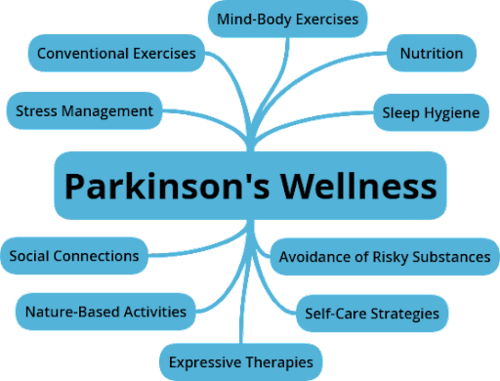Parkinson's Lifestyle Medicine - Wellness and Lifestyle Strategies
Original Editor - Thomas Longbottom based on the course by Z Altug
Top Contributors - Thomas Longbottom, Kim Jackson, Wanda van Niekerk, Jess Bell, Tarina van der Stockt and Jorge Rodríguez Palomino
Introduction[edit | edit source]
Approximately 10 million people around the world are currently living with Parkinson’s Disease.[1] Meta-analysis of worldwide data reveals that the prevalence of Parkinson’s Disease increases with age, quadrupling from a level of almost 0.5% in the seventh decade of life to approximately 2% for those over the age of 80.[2] Other sources report that Parkinson's affects 1.5-2% of the population over the age of 60.[3] Parkinson’s is associated with the loss of dopamine-producing neurons in the substantia nigra of the midbrain, and it is typified clinically by resting tremor, rigidity, and bradykinesia along with a number of non-motor features such as anosmia, sleep behaviour disorder, depression, autonomic dysfunction, and cognitive dysfunction.[4] The aetiology of this disease is not fully understood, but there is some combination of environmental and genetic factors presumed to be causative.[4] Among these are various lifestyle factors such as tobacco use, dietary intake, and physical activity.[5][6]

According to the Lifestyle Medicine Handbook, Lifestyle Medicine involves the use of evidence-based lifestyle therapeutic approaches to treat, reverse, and prevent lifestyle-related chronic disease.[8] These include:
- A predominantly whole food, plant-based diet
- Regular physical activity
- Adequate sleep
- Stress management
- Social connections
- Avoidance of risky substance abuse[8]
The aim of Lifestyle Medicine is to treat the underlying causes of disease rather than just addressing the symptoms. This involves helping patients learn and adopt healthy behaviours. Lifestyle interventions have the potential to impact the prognosis of many chronic diseases, leading not only to better quality of life for many but also potentially reducing their costs to the healthcare system.[9] While a tendency to think of Lifestyle Medicine as being the domain of the physician is understandable, other providers such as dietitians, social workers, behavioural therapists and lifestyle coaches are also integral.[9] It is also well within the scope of the physiotherapist, with diet and nutrition being key elements in many of the conditions managed by physiotherapists, with physiotherapists poised as experts in exercise and movement, and with prevention, health promotion, fitness and wellness being crucial aspects of physiotherapy care.[10]
The focus of this module will be on discussing strategies for persons with Parkinson's related to stress management, the avoidance of risky substance abuse, and the improvement of social connections, along with the benefits of being in outdoor environments.
Strategies for Stress Management[edit | edit source]
What is stress? Per Taber's Cyclopedic Medical Dictionary, it is "any physical, physiological or psychological force that disturbs equilibrium."[3] These disturbances in a person with Parkinson's Disease can have some particular effects. Stress can reduce the effectiveness of levodopa in the medical management of persons with Parkinson's Disease.[11] The ability to cope with stress may help prevent exacerbations of parkinsonian tremors caused by the stress.[12] Chronic stress also has the potential to increase susceptibility to depression and anxiety in persons with Parkinson's.[13] Strategies for stress management can thus be impactful for the person with Parkinson's.
What causes stress? Determining the factors creating stress can be the first step in managing it. Consider the following potential causes of stress:
- Financial concerns
- Family matters
- Work matters, including long commutes to work
- Medical concerns, including lack of quality information regarding the medical condition
- Personal relationships
- Lack of socialization
- Pressure while studying or preparing for a career
- Facing major life changes, such as losing a loved one, changing jobs, or moving to another location
- Times of uncertainty, such as a living during a global pandemic
What are some strategies to manage stress? Once the source of the stress is identified, select strategies may be applied to manage that stress. However, it is important to realize that not all approaches will be appropriate for every person.
Sample patient education strategies to help manage stress:
- Try conventional exercise such as walking, biking, hiking, swimming, etc.
- Try mind body exercise such as tai chi, qigong, or yoga.[14][15][16]
- Try engaging in more outdoor activities.[17]
- Try various types of meditation.
- Try progressive muscle relaxation techniques.
- Try massage therapy.[18]
- Try listening to music.
- Try guided imagery with music.[19]
- Try painting or drawing.
- Try including more laughter into daily life through television, books, or other media.[20]
- Try singing, whistling, or humming.
- Try dancing.
- Try participating in a drama class at a local school or community theatre.
- Try a weighted blanket.[21]
- Try playing with pets.
One other strategy that should be considered is to reduce near point visual stress. The near point is the closest point at which an object can remain in focus on the retina of the eye, and activities requiring prolonged near point focus can cause eye fatigue, eye strain, and headaches.[22] These activities might include close work on computers, phones, books, or other desktop activities. To reduce this stress, try looking away from close work every 10-20 minutes, try using larger font sizes on screens and on patient education/home exercise materials, and try offsetting the close work by taking breaks to exercise outdoors or focus the eyes in the distance.[23][24]
If the above strategies are not effective enough, consider referring the patient to a stress management specialist, psychologist or counselor.
Reducing Risky Substance Abuse[edit | edit source]
It should come as no surprise that harmful use of both alcohol and tobacco can have negative effects on health. According to the World Health Organization, alcohol use is a factor in over 200 disease and injury conditions.[25] Alcohol consumption is also associated with increased risk for progression of Parkinson's. Smoking is associated with an increased risk of mortality, and in persons with Parkinson's it is associated with an increased risk of cognitive decline.[6] It stands to reason that smoking cessation, then, can reduce risk for cognitive impairment in Parkinson's, and this is supported by the evidence.[26]
Treatment for Alcohol Use Disorder: While the ideal mode of exercise, along with intensity, frequency, and duration, isn't known, it is clear that exercise can be an effective treatment for alcohol use disorder.[27] Consider exercise prescription for Parkinson's patients also dealing with alcohol use, designing fitness programs and/or encouraging their use of fitness centers.
Strategies for Smoking Cessation:
One strategy to aid smoking cessation is the use of a yoga routine, with evidence supporting its positive effect on successful abstinence from smoking.[28]The practice of yoga potentially aids efforts at cessation through addressing factors such as stress, cravings, and mindfulness.[28] In the supporting study, the subjects participated in an Iyengar Yoga routine consisting of 5 minutes of breath work, followed by 45 minutes of dynamically linked postures, and then 5-10 minutes of resting meditation.
Another resource the physiotherapy clinician may recommend to their patients is the Smokefree Apps available via smokefree.gov.
Improving Social Connections[edit | edit source]
Benefits of Outdoor Environments[edit | edit source]
Resources[edit | edit source]
- bulleted list
- x
or
- numbered list
- x
References[edit | edit source]
- ↑ Statistics [Internet]. Parkinson's Foundation. [cited 2021Dec28]. Available from: https://www.parkinson.org/Understanding-Parkinsons/Statistics
- ↑ Pringsheim T, Jette N, Frolkis A, Steeves TDL. The prevalence of Parkinson's disease: A systematic review and meta-analysis. Movement Disorders 2014;29(13):1583–90.
- ↑ 3.0 3.1 Venes D, Taber CW. Taber's Cyclopedic Medical Dictionary. Philadelphia, PA: F.A. Davis; 2021.
- ↑ 4.0 4.1 Simon DK, Tanner CM, Brundin P. Parkinson Disease Epidemiology, Pathology, Genetics, and Pathophysiology. Clinics in Geriatric Medicine 2020;36(1):1–2.
- ↑ Ritz B, Ascherio A, Checkoway H, Marder KS, Nelson LM, Rocca WA, et al.. Pooled Analysis of Tobacco Use and Risk of Parkinson Disease. Archives of Neurology [Internet] 2007;64(7):990.
- ↑ 6.0 6.1 Paul KC, Chuang Y, Shih I, Keener A, Bordelon Y, Bronstein JM, et al.. The association between lifestyle factors and Parkinson's disease progression and mortality. Movement Disorders 2019;34(1):58–66.
- ↑ Z Altug. Parkinson's Lifestyle Medicine - Nutrition and Sleep Hygiene. Physioplus Course. 2021.
- ↑ 8.0 8.1 Frates B, Bonnet JP, Joseph R, Peterson JA. Lifestyle Medicine Handbook: An introduction to the power of Healthy Habits. Monterey, CA: Healthy Learning; 2021.
- ↑ 9.0 9.1 1. Bodai B. Lifestyle Medicine: A Brief Review of Its Dramatic Impact on Health and Survival. The Permanente Journal 2017;22(1).
- ↑ Worman R. Lifestyle medicine: The role of the physical therapist. The Permanente Journal. 2020;24:18.192.
- ↑ 1. Zach H, Dirkx MF, Pasman JW, Bloem BR, Helmich RC. Cognitive Stress Reduces the Effect of Levodopa on Parkinson's Resting Tremor. CNS Neuroscience & Therapeutics 2017;23(3):209–15.
- ↑ Jankovic Joseph. Physiologic and pathologic tremors. Annals of Internal Medicine. 1980;93(3):460.
- ↑ Heide A, Meinders MJ, Speckens AEM, Peerbolte TF, Bloem BR, Helmich RC. Stress and mindfulness in parkinson's disease: Clinical effects and potential underlying mechanisms. Movement Disorders. 2020;36(1):64–70.
- ↑ 1. Kwok JYY, Kwan JCY, Auyeung M, Mok VCT, Lau CKY, Choi KC, et al.. Effects of Mindfulness Yoga vs Stretching and Resistance Training Exercises on Anxiety and Depression for People With Parkinson Disease. JAMA Neurology 2019;76(7):755.
- ↑ 1. Wang F, Lee E-KO, Wu T, Benson H, Fricchione G, Wang W, et al.. The Effects of Tai Chi on Depression, Anxiety, and Psychological Well-Being: A Systematic Review and Meta-Analysis. International Journal of Behavioral Medicine 2014;21(4):605–17.
- ↑ 1. Wang C-W, Chan CH, Ho RT, Chan JS, Ng S-M, Chan CL. Managing stress and anxiety through qigong exercise in healthy adults: a systematic review and meta-analysis of randomized controlled trials. BMC Complementary and Alternative Medicine. 2014;14(1):8.
- ↑ Triguero-Mas M, Donaire-Gonzalez D, Seto E, Valentín A, Martínez D, Smith G, et al. Natural outdoor environments and mental health: Stress as a possible mechanism. Environmental Research. 2017;159:629–38.
- ↑ Angelopoulou E, Anagnostouli M, Chrousos GP, Bougea A. Massage therapy as a complementary treatment for parkinson’s disease: A systematic literature review. Complementary Therapies in Medicine. 2020;49:102340.
- ↑ Beck BD, Hansen ÅM, Gold C. Coping with work-related stress through guided imagery and music (GIM): Randomized Controlled Trial. Journal of Music Therapy. 2015;52(3):323–52.
- ↑ Bennett MP, Zeller JM, Rosenberg L, McCann J. The effect of mirthful laughter on stress and natural killer cell activity. Alternative Therapies in Health and Medicine. 2003;9(2):38-45.
- ↑ Eron K, Kohnert L, Watters A, Logan C, Weisner-Rose M, Mehler PS. Weighted blanket use: A systematic review. The American Journal of Occupational Therapy. 2020;74(2).
- ↑ Devora. Near point visual stress (NPVS) [Internet]. Optometrists.org. 2021 [cited 2021Dec30]. Available from: https://www.optometrists.org/vision-therapy/vision-therapy-for-children/checklist-for-parents-2/near-point-visual-stress-npvs/
- ↑ Birnbaum MH. The Use of Stress Reduction Concepts and Techniques in Vision Therapy. Optometry & Visual Performance. 2018Dec;6(6):223–7.
- ↑ Birnbaum MH. Nearpoint visual stress: Clinical implications. Journal of the American Optometric Association. 1985;56(6):480–90.
- ↑ Alcohol [Internet]. World Health Organization. World Health Organization; [cited 2021Dec30]. Available from: https://www.who.int/news-room/fact-sheets/detail/alcohol
- ↑ Guo Y, Xu W, Liu FT, Li JQ, Cao XP, Tan L, et al. Modifiable risk factors for cognitive impairment in parkinson's disease: A systematic review and meta‐analysis of prospective cohort studies. Movement Disorders. 2019;34(6):876–83.
- ↑ Lardier DT, Coakley KE, Holladay KR, Amorim FT, Zuhl MN. Exercise as a useful intervention to reduce alcohol consumption and improve physical fitness in individuals with alcohol use disorder: A systematic review and meta-analysis. Frontiers in Psychology. 2021;12.
- ↑ 28.0 28.1 1. Bock BC, Dunsiger SI, Rosen RK, Thind H, Jennings E, Fava JL, et al.. Yoga as a Complementary Therapy for Smoking Cessation: Results From BreathEasy, a Randomized Clinical Trial. Nicotine & Tobacco Research 2019;21(11):1517–23.








